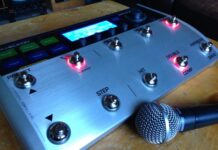Harmonies
One of the most important features of many vocal effects processors is its ability to add one or more harmonies to a part that is being sung. Many of these can use guitar or instrument inputs to automatically change the harmonies so as to fit the chords that are being played and the note that you are singing (and this is a feature that is called Smart Guitar-Controlled Harmony). Without this feature, you would need to manually set the key for each song and change patches if you want to adjust the interval of the harmonies with that specific key. The number of simultaneous harmonies varies between each pedal, giving you 1 to 4 extra voices. You can teak the character of the harmonized voices in many ways like pitch and timing variations and even the gender.
Pitch Correction or Autotune
Pitch correction has taken some part of music by storm and it is not only used to fix tuning problems, but it is also used to give a distinctive sound. It can come in handy if you are looking for some discreet help with a few tough songs or if you want to sound like T-Pain or Kanye West, or any other popular artist. You can control how pronounced the effect is of pulling the pitch of your voice toward the desired note. If you are looking for a natural sound the you would need to lower the speed and the amount of correction would be better.
The Hard Tune effect helps to lock the pitch to a target note very quickly and it creates the artificial sound and would result in a rapid warbling if you drift between notes. Many vocal effects processors allow you to set a scale to tune to, but the chromatic mode should be enough if you are getting anywhere near that note. But the scale setting can be quite useful for that pronounced hard tune warbling effect so as to control which notes it warbles between.






